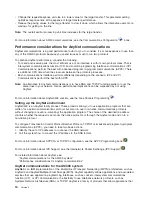
Performance considerations for Common Programming Interface
Communications
You can use Common Programming Interface Communications (CPI Communications) to write application
programs that you want to communicate with advanced program-to-communications (APPC). The interface
makes use of the System Network Architecture (SNA) LU (logical unit) 6.2 architecture to do the following:
v
Establish a conversation
v
Send and receive data
v
Exchange control information
v
End a conversation
v
Notify a partner program of errors.
Intersystem communications feature (ICF) and CPI Communications programs have similar performances
for small data transfers.
To optimize CPI Communications application programs, do the following:
v
Minimize the use of flush and confirm.
v
Receive a compile record and parse it in your buffer.
v
Do not use multiple receive calls to receive a single record.
v
Use Request-to-Send only when necessary.
To add or change communications entries to get the system set up for CPI Communications, do the
following:
1. Type appropriate command on the AS/400 command line and press F4.
v
Add Communications Entry (ADDCMNE)
v
Remove Communications Entry (RMVCMNE)
v
Change Communications Entry (CHGCMNE)
2. Use the online help information to change, add, or remove parameter values.
3. Press Enter. The communications entries are added, changed or removed.
For more information about configuring CPI Communications, see:
v
“Application program interface (API) performance considerations” on page 17
v
CICS/400 Administration and Operations Guide
Chapter 4. Communications applications
19
Summary of Contents for AS/400
Page 1: ...iSeries Networking iSeries Communications Management ERserver...
Page 2: ......
Page 3: ...iSeries Networking iSeries Communications Management ERserver...
Page 8: ...2 Version 5...
Page 10: ...4 Version 5...
Page 12: ...6 Version 5...
Page 22: ...For more information about creating subsystems see the Work Management book 16 Version 5...
Page 26: ...20 Version 5...
Page 34: ...Example 3 AS 400 system for DLUR support with the host system 28 Version 5...
Page 36: ...30 Version 5...
Page 46: ...40 Version 5...
Page 57: ...Chapter 7 Communicating with remote workstation controllers 51...
Page 63: ...Chapter 7 Communicating with remote workstation controllers 57...
Page 82: ...Example 2 AS 400 to 4690 PEER connection over token ring network 76 Version 5...
Page 83: ...Chapter 7 Communicating with remote workstation controllers 77...
Page 84: ...78 Version 5...
Page 102: ...96 Version 5...
Page 103: ......
Page 104: ...Printed in U S A...
















































